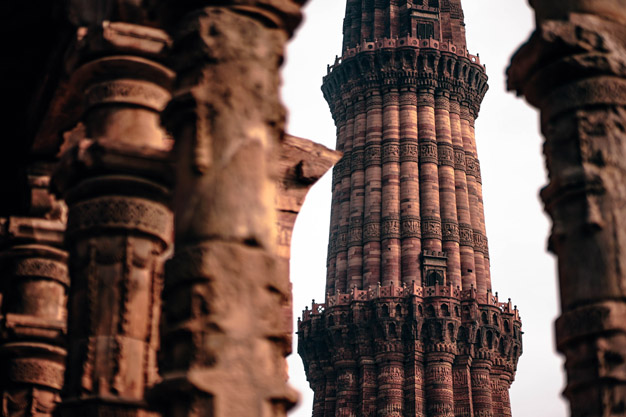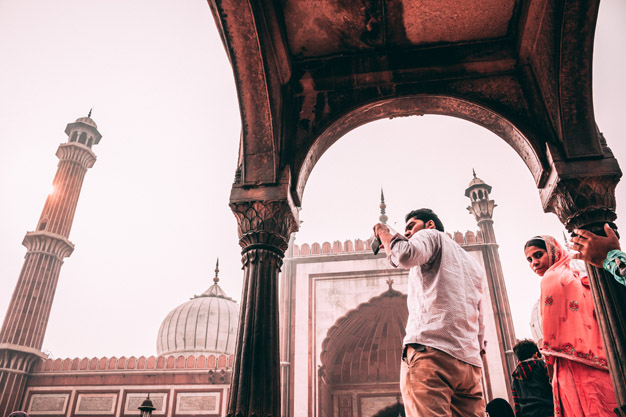Exploring Delhi's Eight Historic Cities
October 2018
At first glance, Delhi embodies all that is exasperating and chaotic about modern India. It can take nerves of steel to face the frenetic pace at which it whirls through daily life. But grant Delhi a more discerning gaze and you’ll uncover a host of redeeming features. Topping the list is Delhi’s historical legacy, with the ruins of eight ancient cities peeking out through the city streets, from Islamic citadels and the mausoleums of Sufi saints, to the colonial flourishes of Edwin Lutyens in New Delhi. Taking the Delhi Tourism HoHo Bus is a handy way to time-travel across this ancient octet, but the Metro runs close to most of the historic sights.
Delhi's first foundations at Lal Kot
Early records link Delhi to the mystical city of Lal Kot, founded by the Hindu king Anangpal Tomar in the eighth century, but apart from remnants of an easily missed fort wall beyond the Qutb Minar, little remains of the city that thrived here for over 300 years. More can be seen of Qila Rai Pithora, established by King Prithviraj Chauhan, who seized, rechristened and expanded Lal Kot in the 11th century. Punctuated by bastions, the once impenetrable walls today enclose a well-maintained public park along the Saket-Mehrauli Road. A circular building across from the main gate contains a small library, crowned by a massive statue of the legendary Rajput ruler.
The Qutb Minar and mighty Mehrauli
In the 12th century, the Mamluks, first of four consecutive Turkic dynasties to rule Delhi, arrived on the scene, founding another new capital at Mehrauli. To celebrate, the victorious sultan Qutbuddin Aibak commenced with the construction of the Qutb Minar, the tallest brick minaret in the world at 73m – sadly, it can no longer be climbed after a deadly stampede in 1981. One of Delhi’s top tourist attractions, the sprawl of ruins also includes the Quwwat ul Islam, reportedly north India’s first ever mosque. More Mamluk-era buildings are dotted around the Qutb Minar complex, but the Mehrauli area is going upmarket, with high fashion design stores, lifestyle boutiques, buzzing fine-dining and hip casual cafes. In September, Mehrauli is the focal point for Phoolwalon ki Sair, when flower vendors offer floral offerings at shrines, praying for an efflorescent Spring.
Seeking Siri at Hauz Khas
Sultan Alauddin Khilji is credited with building the third city of Delhi, to the northeast of Mehrauli, at the end of the 13th century. Siri was long ago consumed by the urban sprawl, but some extant ruins, reminiscent of Turkish forts, are visible along Khel Gaon Marg. You’ll pass them en route to the Siri Fort Auditorium, site of many a film festival premier. The neighbouring village of Shahpur Jat offers up plenty of trendy eateries. For more prominent Khilji footprints, you’ll need to head to the ancient reservoir and Islamic seminaries of Hauz Khas village. When you tire of exploring ruins, fall back on countless cafes, boutiques, nightclubs and watering holes in this hip and happening neighbourhood.
The towering walls of Tughlaqabad
On assuming power at the turn of the 14th century, the founder of the next dynasty, Ghiyas-ud-din Tughlaq, built yet another citadel in the hills to the southeast of Delhi. The ruins today are overgrown and largely forgotten; even the imposing Tughlaqabad Fort – home to some impressive Tughlag-era tombs – is overrun by goats and weeds. The next sultan, Mohammad bin Tughlaq, was prone to flights of fancy, and shifted his capital to Maharashtra soon after, but he returned to build Jahanpanah, another mighty city now lost to history. The Khirki Mosque, a geometrical marvel accessed from a narrow alley across the road from Select Citywalk Mall in Saket, is one of few tangible surviving relics.
Fascinating Firoz Shah Kotla
Firoz Shah, last of the Tughlaq monarch, moved his seat to the banks of the Yamuna River in the middle of the 14th century, but unlike in most of Delhi’s vanished cities, the ruins he left behind are still an active place of worship. Every Thursday, the gardens enveloping the atmospheric palace ruins teem with worshippers headed to the mosque at the heart of the compound. A pillar carved on the orders of the emperor Ashoka in the 3rd century BCE hints at far older history. Within bowling distance on Bahadur Shah Zafar Marg, the Feroz Shah Cricket ground was built in 1883, making it the second oldest cricket ground in India, after the Eden Gardens in Kolkata.
Towards the end of the century, the Tughlaqs made way for the Sayyids and Lodis, who left a lavish legacy of elegant tombs and mausoleums, scattered around the peaceful grounds of the Lodi Gardens near Khan Market. Look out for the uncharacteristically plain tomb of Ibrahim Lodi, whose defeat at the hands of Babur finally ushered in the Mughal era in 1526.
The Purana Qila, heart of short-lived Shergarh
The rule of Humayun, the second Mughal Emperor, was interrupted briefly by Sher Shah Suri, a feisty Afghan soldier who stormed into town in 1540. Humayun’s half-finished fort, Dinpanah, was captured and renamed Shergarh, but just 15 years later, Sher Shah tripped down the stairs of his private library and died from his injuries, putting the Mughals firmly back in the saddle.
Sher Shah’s architectural efforts, collectively referred to as the Purana Qila, are mostly in good repair, set in expansive grounds off Mathura Rd, near the National Stadium.
The octagonal jewel box of the Sher Mandal was the site of Sher Shah’s fatal fall, and nearby is the magnificent Qila-e-Kuhna Mosque, finished in red sandstone and gleaming white marble. A sound and light show illuminates the ruins daily (except Fridays) from February to April. While here, you can duck south to the green surrounds of Delhi Zoo, or check out what is taking place at the Pragati Maidan, a 150-acre exhibition space that hosts the annual India International Trade Fair every November.
Finding Shajahanabad in the streets of Old Delhi
In 1648, Shah Jahan, the fifth Mughal emperor, built Delhi’s seventh city and called it Shajahanabad, now popularly known as Old Delhi. An aesthete by nature, he bequeathed Delhi many of its most majestic monuments. The Red Fort, from whose sandstone ramparts Indian Prime Ministers address the nation on Independence Day, is Delhi’s signature building, the seat of the Mughals until the last emperor was exiled by the British in 1858.
To see more Shajahanabad wonders, duck into the bazaars of Chandni Chowk. At the heart of the maze of bustling alleyways and wholesale markets is the landmark Jama Masjid, arguably the most perfectly proportioned mosque in India, and also its largest. The street food of Chandni Chowk is legendary amongst Delhiites, with Karim’s topping the list for meaty Mughlai meals, and Gali Paratha Wali for Punjabi paratha breakfasts.
Navigating the colonial corners of New Delhi
If Old Delhi was the soul of the Mughal city, New Delhi was where the British stamped their identity onto India. Mughal power was already in decline when the British Resident arrived in 1803, but it was only in 1911 that King George V anointed Delhi as the capital of British India – a rather lonely obelisk inside Coronation Park marks the spot where he made the announcement. Shortly after, the construction of New Delhi, the eighth and last city developed under foreign rule, began.
Named for the British architect credited with fashioning the Delhi order of architecture, Lutyens Delhi is where the seat of Indian democracy lies today. Most visitors know Connaught Place and India Gate, but the surrounding district is an orderly spread of leafy boulevards lined with elegant bungalows, stately homes, grand offices, museums and art galleries. With the exit of the British in 1947, Indian politicians took over control of the grand civic buildings along Rajpath. Today, the flag of independent India flies proudly over Parliament House and Rashtrapati Bhawan, but tucked behind is another reminder of Delhi’s richly layered history, the Mughal Gardens, created by Lutyens but inspired by the grand civic gardens of the Mughal empire.
Also read: Best Things To Do In Shimla
To Know More Information About Thane Travel Blog, Travel Tips and Tricks, Article, Resources By Crossworld Holidays- Domestic Tour Operator in Thane
Read all Tours and Travel Blog, Resources Thane by Crossworld Holidays
Share This:
Source - lonelyplanet.com
Crossworld Holidays gives the Domestic Package Tours Booking Thane Contact us at (+91) 4038 4747 or Email us at - info@crossworldholidays.com

